Search results for: 'Art'
-
 Perle der Manabí-Kultur aus der Prä-Inka-Zeit Ecuadors
Perle der Manabí-Kultur aus der Prä-Inka-Zeit Ecuadors500 n. Chr. bis 1500 n. Chr., Präinkazeit und Präkolonialzeit. Bichrome Tonperle mit kunstvoller Miniaturszene, dargestellt ist ein Vogel.
Price: on request Manabí-Perle aus dem präkolonialen Südamerika - Seevogel
Manabí-Perle aus dem präkolonialen Südamerika - SeevogelPräinkazeit und Präkolonialzeit, 500 n. Chr. bis 1500 n. Chr. Darstellung eines Seevogels in Ritztechnik. Eindrucksvolle Bearbeitung.
Price: on request Gold figurine of a quadruped from Colombia
Gold figurine of a quadruped from ColombiaBeautiful small gold figure from the pre-Columbian Quimbaya culture, made by lost wax casting around 1000 years ago.
€5,400 Persian bowl from Golestan
Persian bowl from GolestanNicely decorated with plant ornaments in black and turquoise. Made towards the end of the Islamic Golden Age in the Persian province of Golestan.
Price: on request Persian jug from Sultanabad
Persian jug from SultanabadImpressive pottery with turquoise glaze and black paint. From 13th century Iran. With a letter from the Royal Victoria and Albert Museum.
€1,040 Tall bone pyxis
Tall bone pyxisInteresting cylindrical vessel with rich decoration. From antiquity or early Middle Ages.
Price: on request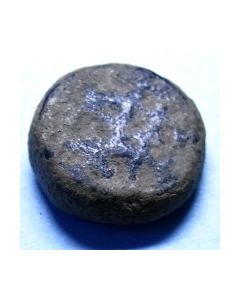 Bronzegewicht, Islamisch, 1 2/3 Mithqal
Bronzegewicht, Islamisch, 1 2/3 MithqalLevante, 6 Jh. n.Chr. bis 10 Jh. n. Chr., spätbyzantinische bis islamische Epoche. Entsprechende antike Gewichtseinheit: 1 und 2/3 Mithqal (Mitqals).
Price: on request Two mosaic glass beads
Two mosaic glass beadsBeautifully patterned old glass beads from Murano and Syria. Ex Christie's.
€490 Large ceremonial knife of the Sican culture
Large ceremonial knife of the Sican cultureThe so-called Tumi was a weapon to cut the throats of humans and animals in ritual sacrifices. The knife certainly fulfilled an additional representative function in the afterlife. From the period of the Sican's cultural florescence during the 10th to 12th centuries AD.
Price: on request Ceremonial knife of the Sican culture
Ceremonial knife of the Sican cultureThe so-called Tumi was a weapon to cut the throats of humans and animals in ritual sacrifices. The knife certainly fulfilled an additional representative function in the afterlife. From the period of the Sican's cultural florescence during the 10th to 12th centuries AD.
Price: on request Small ceremonial knife of the Sican culture
Small ceremonial knife of the Sican cultureThe so-called Tumi was a weapon to cut the throats of humans and animals in ritual sacrifices. The knife certainly fulfilled an additional representative function in the afterlife. From the period of the Sican's cultural florescence during the 10th to 12th centuries AD.
Price: on request Huge ceremonial knife of the Sican culture
Huge ceremonial knife of the Sican cultureThe so-called Tumi was a weapon to cut the throats of humans and animals in ritual sacrifices. The knife certainly fulfilled an additional representative function in the afterlife. From the period of the Sican's cultural florescence during the 10th to 12th centuries AD.
€515 Ceremonial knife of the Sican culture
Ceremonial knife of the Sican cultureThe so-called Tumi was a weapon to cut the throats of humans and animals in ritual sacrifices. The Tumi certainly fulfilled an additional representative function in the afterlife. From the period of the Sican's cultural florescence during the 10th to 12th centuries AD.
Price: on request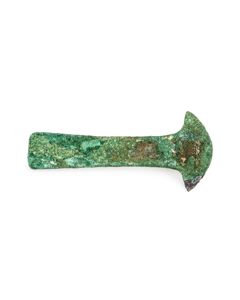 Ceremonial knife of the Sican culture
Ceremonial knife of the Sican cultureThe so-called Tumi was a weapon to cut the throats of humans and animals in ritual sacrifices. The knife certainly fulfilled an additional representative function in the afterlife. From the period of the Sican's cultural florescence during the 10th to 12th centuries AD.
Price: on request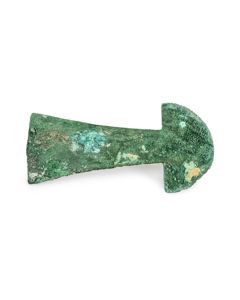 Large ceremonial knife of the Sican culture
Large ceremonial knife of the Sican cultureThe so-called Tumi was a weapon to cut the throats of humans and animals in ritual sacrifices. The knife certainly fulfilled an additional representative function in the afterlife. From the period of the Sican's cultural florescence during the 10th to 12th centuries AD.
€420 Byzantine bronze processional cross holder
Byzantine bronze processional cross holderExcellent condition, beautiful patina, worth the exhibition in a museum. Middle Byzantine Period, Constantinople or Asia Minor workshop.
€4,930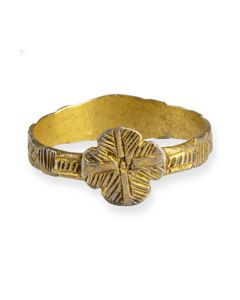 Medieval gilt finger ring
Medieval gilt finger ringThe ring from the late Middle Ages was found in England. The silver body and the gold plating are in excellent condition. Appraised at the British Museum, published in the Portable Antiquities Scheme database.
Price: on request Japanese Katana forged around 1430
Japanese Katana forged around 1430Excellently preserved samurai sword made in the Muromachi period. From the collection of a Munich lawyer, acquired in the 1970s.
Price: on request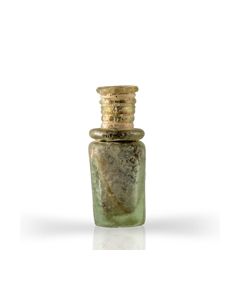 Square bottle of thick glass
Square bottle of thick glassSmall ancient glass flask, like they are found along the old trade routes of the Islamic world. Such bottles were used around 1000 years ago to transport precious oils and other liquids.
€465 Anglo-Saxon gilt bow brooch
Anglo-Saxon gilt bow broochA find from the Isle of Wight from the Migration Period. Beautiful testimonial of the settlement of Britain by the Anglo-Saxons.
Price: on request Anglo-Saxon bow brooch
Anglo-Saxon bow broochA find from the Isle of Wight from the Migration Period. Beautiful testimonial of the settlement of Britain by the Anglo-Saxons.
Price: on request Anglo-Saxon bow brooch
Anglo-Saxon bow broochA find from the Isle of Wight from the Migration Period. Beautiful testimonial of the settlement of Britain by the Anglo-Saxons.
Price: on request Stirrup vessel in squash shape
Stirrup vessel in squash shapeGreat example of the intricately designed vessels of the Peruvian Chimú culture, decorated with a monkey and birds. The squash was an important fruit in the pre-Columbian Kingdom of Chimor.
€1,570 Stirrup vessel as a water bird
Stirrup vessel as a water birdPlastically shaped vessel from the Peruvian Chimú culture, showing a water bird. From the 15th century. With TL report from 1979.
€910 Large Visigoth bow brooch
Large Visigoth bow broochImpressive fibula of the Visigoths from the Migration Period. With five originally preserved glass inserts.
Price: on request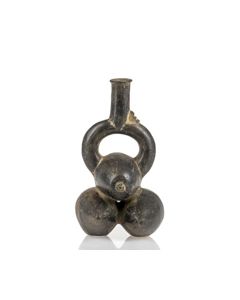 Stirrup vessel in the shape of cacao fruits
Stirrup vessel in the shape of cacao fruitsPlastically shaped vessel from the Peruvian Chimú culture. It embodies an important agricultural product of the pre-Columbian civilization of Chimor. With TL report from 1979. Part of a special exhibition from 2024 to 2025.
€1,600 Roman and medieval potsherds from the Rhineland
Roman and medieval potsherds from the RhinelandFragments of Roman and medieval pottery. Finds from the Roman city of Novaesium, today's Neuss in Germany, an early Roman foundation and with this one of the oldest cities in Germany.
Price: on request

